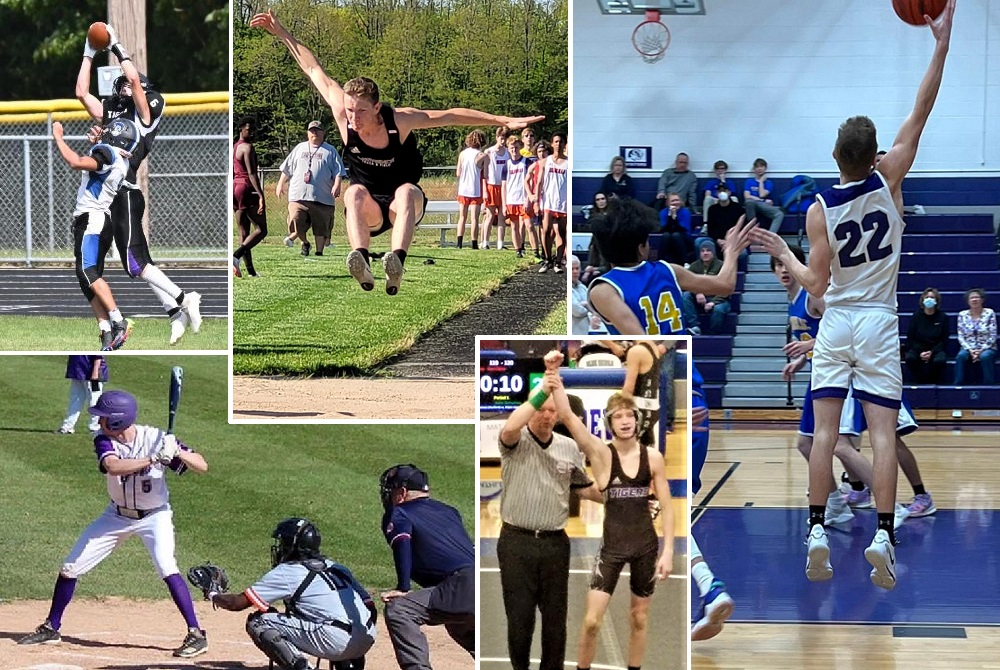
Inside Selection Sunday: Mapnalysis '13
October 28, 2013
By Geoff Kimmerly
Second Half editor
At the end of the day – Sunday, in this case – the 2013 MHSAA football playoff field was determined based on a set of numbers we began working with long before the first kickoff of this season.
So to kick off our discussion of how some of the 2013 playoff-selection decisions were made, here are a few numbers that might boggle the mind – or at least surprise:
- A total of 3,111 high school results were used in determining this season’s field – 2,978 for 11-player and 133 for 8-player games.
- We inputted and then followed the schedules for 623 MHSAA teams.
- We also inputted and followed weekly the schedules for 50 teams from surrounding states and Ontario that played at least one game against one of our MHSAA schools.
- We worked through complicated maneuverings made necessary by seven teams playing a mix of 11 and 8-player games, plus two more teams that played a mix of varsity and junior varsity opponents.
- And by Sunday morning we ended up with a few more numeric rarities: only 225 automatic qualifiers, the fewest since the current playoff system was introduced in 1999, and also an uneven number of at-large bids from our four classes because only six Class D teams reached the number of victories needed to be considered. (This was balanced by taking more at-large qualifiers from Classes A, B and C.)
And that was just the start of one of our most exciting days of the school year.
Following are more details. First, I explain some of the history of the MHSAA playoffs – I’ve lifted this in part from our 2012 report, so skip ahead if you’ve already got that down. Next, I touch on five themes that emerged as we built the brackets for this season’s tournament.
The process
Our past: The MHSAA playoff structure – with 256 teams in eight divisions, and six wins equaling an automatic berth (or five wins for teams playing eight or fewer games) – debuted in 1999, as mentioned above. An 8-player tournament was added in 2011, resulting in nine champions total when November is done.
That’s a long way from our start. The first playoffs were conducted in 1975 with four champions. Four more football classes were added in 1990 for a total of eight champions each fall. Through 1998, only 128 teams made the postseason, based on their playoff point averages within regions (four for each class) that were drawn before the beginning of the season. The drawing of Districts and Regions after the end of the regular season did not begin until the most recent playoff expansion.
In early years of the current process (or until the middle of the last decade), lines were drawn by hand. Dots representing qualifying schools were pasted on maps, one map for each division, and those maps were then covered by plastic sheets. Districts and Regionals literally were drawn with dry-erase markers.
Our present: After a late Saturday night tracking scores, we file in as the sun rises Sunday morning for a final round of gathering results we may still need (which can include making a few early a.m. calls to athletic directors). Then comes re-checking and triple-checking of enrollments, what schools played in co-ops, some records and more before the numbers are crunched and the fields are set.
Those 256 11-player teams are then split into eight equal divisions based on enrollment, and their locations are marked on digital maps that are projected on wall-size screens and then discussed by nearly half of the MHSAA staff plus a representative from the Michigan High School Football Coaches Association. Only the locations themselves are marked (by yellow dots) – not records, playoff point averages or names of the schools or towns. In fact, mentions of those are strictly prohibited. Records and playoff points are not part of the criteria. Matchups, rivalries, previous playoff pairings, etc. also DO NOT come into play. The same process is followed for organizing the 8-player bracket.
Observations and answers: 2013
This doesn’t happen overnight: Preparation for selecting the MHSAA playoff field begins long before the first kickoff of fall, much less the first practice. We load schedules for all 600-plus varsity teams during the summer, and many schedules remain fluid right up until the first Friday of the season – and this fall, a few weren’t settled until Week 2 or 3.
This summer as in some past we also worked through schools closing (Inkster, Saginaw Buena Vista, Detroit Northwestern, Flint Northern), and others deciding in mid-July and early August they would not field teams because of a lack of players.
Sometimes we have to take odd paths to find scores for these games. The last 11-player score to be added to our data this regular season came in as a result of tweeting the sports anchor of a Wheeling, W.Va., television station. Our last 8-player score came in via email from a Wisconsin athletic director at 10:30 Saturday night. Thankfully, we get plenty of assistance from some of our friends in the field, who keep an eye on the data and alert us when something appears missing or incorrect.
Win and advance: This season’s list of 5-4 teams includes a number of heavy hitters that did not receive at-large bids – East Grand Rapids, Utica Eisenhower, Orchard Lake St. Mary’s and Flint Powers Catholic to name a few. All were solid teams and played strong competition. All missing the playoffs likely raised some eyebrows.
But we have to take a look at this from a statewide view. There admittedly can be some argument about what schools qualified for the 226-256 spots in the field – but the important part is that 225 qualified because they all met the minimum win requirement. A playoff is simply that – it decides a champion based on teams winning. For some it’s harder to pile wins, of course, because they play in tough leagues. But the winners of those leagues are in the field – and surely will credit that tough road with getting them prepared to now play the state’s best.
Geography rules: This long has been rule number one for drawing MHSAA brackets in any sport, and is a repeat as well for those who have read this report the last two Octobers. Travel distance and ease DO come into play. Jumping on a major highway clearly is easier than driving across county-wide back roads, and that’s taken into consideration.
Also, remember there’s only one Mackinac Bridge and hence only one way to cross between peninsulas – and boats are not considered a possible form of transportation. When opponents from both peninsulas will be in the same District, distance to the bridge is far more important than as the crow flies.
The best example of this comes this season in Division 5. Grayling clearly is east of both Kingsley and Kalkaska – but also sits on I-75, while those two do not. So while those more western teams are geographically closer to Houghton, Menominee and Kingsford from the Upper Peninsula, we instead paired the three U.P. teams with Grayling because being on a main highway made for a shorter trip. The trip to Grayling for any of those U.P. teams would be 36 miles shorter to Grayling than Kingsley and 13 miles shorter to Grayling than Kalkaska.
Sometimes it’s where the points aren’t: Sure, it would be best-case scenario to have perfect sets of eight dots split into four quadrants from Calumet to Bedford. But generally that doesn’t occur. “Dots determine the map” is a common phrase heard here during this selection process, but that works the other way as well. If there are no qualifiers in a division from a specific area of the state – see Division 1, with none south of Holland or west of the greater Lansing area – there’s no choice but to create the unusual Regional Final possibility of Traverse City West vs. Brighton. Brighton is simply closer to the west side of the state than our other options.
Border to border vs. coast to coast: Should Regions be grouped north to south or east to west? There isn't a right or wrong answer – it just depends on that set of dots.
Whenever we have Upper Peninsula teams in a division, they’ll be grouped with those from the northernmost points of the Lower Peninsula for a District. The next northernmost schools will be grouped into a District, and together those eight will form a Region.
But the tough decision comes with the other six Districts. Look at this season’s Division 5 map: Six Districts are grouped south of U.S. 10 with three near or west of U.S. 127 and three east of that highway, which runs through the center of the Lower Peninsula. We grouped the two southwestern Districts into a Region and the two southeastern Districts into a Region – leaving a final Region that stretches from Muskegon on Lake Michigan to Almont, about 35 miles west of Lake Huron.
That’s a haul. But it’s also the best of our possible compromises. We could’ve instead paired regions that would’ve stretched from Hopkins to Monroe – only 19 fewer miles in distance than Muskegon Oakridge to Almont, but a scenario that could’ve created travel increases for a number of additional teams. Another option included a possible trip from Detroit University Prep to Freeland, which also would take more than two hours.
Bottom line – it’s been written here before – we pour all we have into this process, asking questions often more than once until we come up with a consensus. We do appreciate the arguments that arise once brackets are released to the public: The discussions are proof of how much players, coaches and fans care – and often show us new ways we can look at a system that’s now 15 years old.
But we must remember that the good news is the tournament is still set up to reward nine champions over the next five weeks, and five schools – Auburn Hills Oakland Christian, Coldwater, Detroit Allen, Eaton Rapids and Muskegon Mona Shores – will be competing for those titles for the first time.
It’s not so much how the tournament starts as how it ends. And we’re preparing for nine more memorable conclusions.
PHOTO: Each collection of grouped dots is a District on this season's Division 3 playoff map.

Lawrence's Schuman Sets Example for Well-Rounded Success
By
Pam Shebest
Special for MHSAA.com
December 14, 2022
LAWRENCE — If redshirting was a thing in high school, at least two coaches at Lawrence would stick that label on senior John Schuman.
 “We don’t want to lose this kid ever,” said Derek Gribler, the Tigers’ first-year varsity football and baseball coach.
“We don’t want to lose this kid ever,” said Derek Gribler, the Tigers’ first-year varsity football and baseball coach.
“If we could put a red shirt on this kid every year, we would.”
Athletic director John Guillean, who also coaches varsity basketball, agreed.
“He is what we strive to have all our student-athletes achieve: high GPAs, multi-sport athletes, good, overall well-rounded human beings,” Guillean said.
Schuman has participated in five of the seven boys sports Lawrence sponsors.
As a freshman and sophomore, Schuman played football, wrestled, ran track and played baseball.
He had wrestled since he was 4, and went from the 119-pound weight class as a freshman to 145 the following year. That sophomore season he qualified for his Individual Regional. But as a junior, he traded wrestling for basketball.
“My older brother wrestled at Lawrence, so I would come to practices,” he said. “I quit for a couple years (in middle school) because I liked basketball, too. It was hard to do both. Obviously, in high school, I still struggled with choosing,” he added, laughing.
 Guillean is thrilled Schuman made the switch.
Guillean is thrilled Schuman made the switch.
“He’s 6-(foot-)4, he’s super athletic, defensively he’s a hawk, offensively he can put the ball in the bucket. But really, aside from his skills, just that positive attitude and that positive outlook, not just in a game, but in life in general, is invaluable,” the coach said.
Last season, Schuman earned honorable mention all-league honors in the Berrien-Cass-St. Joseph Conference, averaging 9.1 points and 9.1 rebounds per game.
Lawrence left the BCS for the Southwest 10 Conference this year, joining Bangor, Bloomingdale, Hartford, Decatur, Comstock, Marcellus, Mendon, Centreville, White Pigeon and Cassopolis. Schuman and senior Tim Coombs will co-captain the Tigers, with Guillean rotating in a third captain.
At a school of fewer than 200 students, Schuman will help lead a varsity team with just nine – joined by seniors Andy Bowen and Gabe Gonzalez, juniors Christian Smith, Noel Saldana, Ben McCaw and Zander Payment, and sophomore Jose Hernandez, who will see time with the junior varsity as well using the fifth-quarter rule.
“I attribute a lot of (last year’s successful transition) to my coach, helping me get ready because it wasn’t so pretty,” the senior said. “But we got into it, got going, and my teammates helped me out a lot.”
Great anticipation
Gribler is one coach already looking ahead to spring sports after seeing what Schuman did during football season.
In spite of missing 2½ games with an injury, the wide receiver caught 50 receptions for 870 yards and 11 touchdowns.
“I just like the ability to run free, get to hit people, let out some anger,” Schuman laughed.
 Gribler said the senior is “an insane athlete.
Gribler said the senior is “an insane athlete.
“On top of his athletic ability, how smart he is in the classroom (3.88 GPA), he helped mold the culture we wanted this year for football. He got our underclassmen the way we wanted them. He was a big asset in many ways.”
Schuman earned all-conference honors for his on-field performance in football as well.
“I would say that my main sport is football,” the senior said. “That’s the one I like the most, spend the most time on.”
In the spring, Schuman competed in both track and baseball, earning all-conference honors in both.
“Doing both is tough,” he said. “I have to say my coaches make it a lot easier for me. They help me a lot and give me the ability to do both, so I really appreciate that.
“Throughout the week you’re traveling every day, it seems like. Baseball twice a week and track, but it’s worth it.”
Schuman’s commitment is so strong that he made a special effort not to let his teammates down last spring.
“He qualified for state in the long jump and did his jumps up in Grand Rapids, then he drove all the way to Kalamazoo to play in the District baseball game,” Guillean said. “That speaks volumes about who this kid is. He did his jumps at 9 a.m. (but did not advance) and made it back to Kalamazoo for a 12:15 game.”
Big shoes to fill
As the youngest of four children of Mark and Gretchen Schuman, the senior was following a family tradition in sports.
Oldest brother Matthew played football, basketball and baseball as well as competed in pole vault and wrestling.
Middle bother Christopher competed in football, wrestling and baseball.
Sister Stephanie played basketball, volleyball and softball.
“I like to say they blazed a pretty good trail for me at this high school,” Schuman said.
As for feeling pressure to live up to his siblings, “I used to when I was younger, but now I feel like I’ve made my own way and done enough things to be proud of that I’m happy with it.”
His own way led him to achieve something none of the others did.
He was named the Tigers’ Male Athlete of the Year, just the third junior to earn the boys honor over the last 25 years.
“I was very honored to win that as a junior,” Schuman said. “There were good athletes in the grade above me. I guess hard work pays off.”
Guillean said while Schuman is “darn good at every sport here,” an athlete does not have to be a “top dog” in every sport.
“Learn how to take a back seat,” he said. “Learn how to be a role player. That will make you a better teammate and a well-rounded human being.
“Johnny has that work ethic, in the classroom, on the field, on the court, on the track. It doesn’t go unnoticed and, obviously, he’s reaping the benefits now.”
 Pam Shebest served as a sportswriter at the Kalamazoo Gazette from 1985-2009 after 11 years part-time with the Gazette while teaching French and English at White Pigeon High School. She can be reached at [email protected] with story ideas for Calhoun, Kalamazoo and Van Buren counties.
Pam Shebest served as a sportswriter at the Kalamazoo Gazette from 1985-2009 after 11 years part-time with the Gazette while teaching French and English at White Pigeon High School. She can be reached at [email protected] with story ideas for Calhoun, Kalamazoo and Van Buren counties.
PHOTOS (Top) Lawrence’s John Schuman has participated in five varsity sports during his first 3½ years of high school. (Middle) Lawrence athletic director John Guillean. (Below) Lawrence football and baseball coach Derek Gribler. (Action photos courtesy of John Schuman; head shots by Pam Shebest.)

